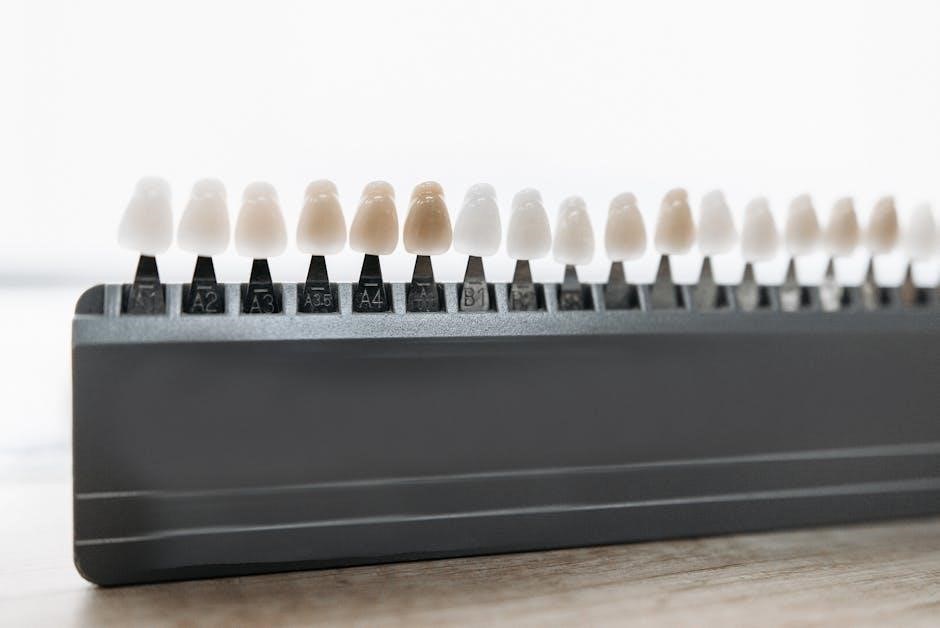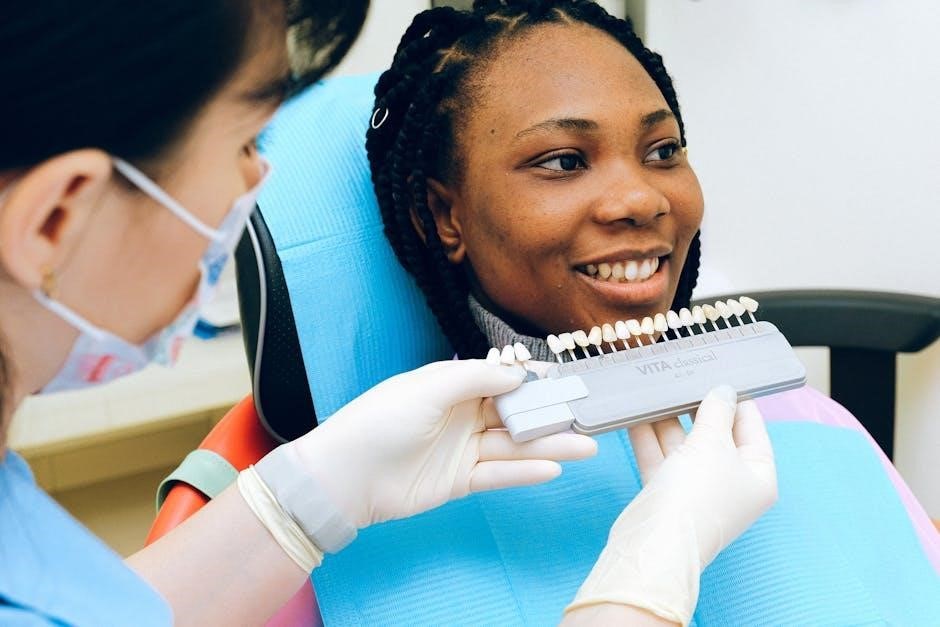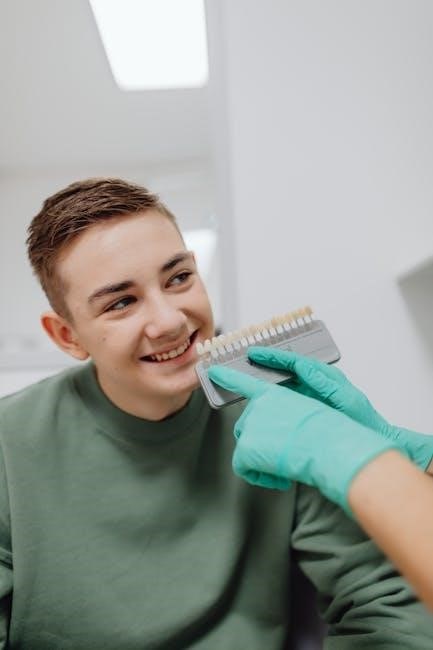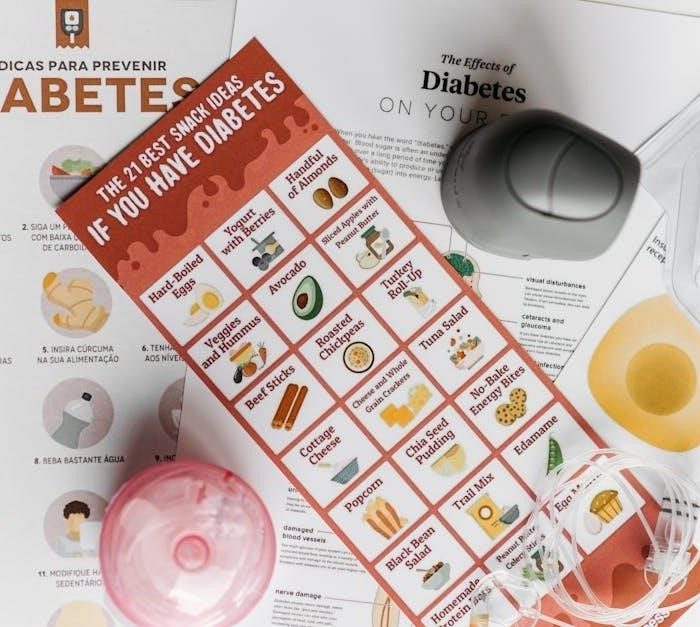Guided Tissue Regeneration (GTR) is a dental procedure designed to regenerate lost bone and gum tissue, addressing periodontal defects and enhancing implant placement success rates effectively.
1.1 Definition and Purpose of GTR
Guided Tissue Regeneration (GTR) is a surgical procedure in dentistry aimed at regenerating lost periodontal tissues, including bone and gum, to restore tooth support and stability. Its primary purpose is to address advanced periodontal disease and defects, promoting the growth of healthy tissue in areas where it has been destroyed. GTR involves the use of barriers or membranes to guide the healing process, ensuring that the desired tissue regenerates correctly. This technique is particularly useful in cases where bone loss has compromised tooth stability or implant placement. By facilitating natural tissue repair, GTR enhances dental reconstruction outcomes, offering a biologically based approach to treating periodontal defects and improving patient oral health. Its application is integral to modern regenerative dentistry practices.

1.2 Historical Development of GTR in Dentistry

The concept of Guided Tissue Regeneration (GTR) emerged in the mid-20th century, evolving from early attempts to regenerate bone and periodontal tissues. Initial experiments in the 1950s and 1960s focused on bone grafting techniques to address periodontal defects. The 1980s marked a breakthrough with the introduction of barrier membranes to guide tissue growth, distinguishing GTR from conventional grafting methods. These innovations laid the foundation for modern GTR, which integrates resorbable and non-resorbable materials. Over time, advancements in biomaterials and surgical techniques have refined the procedure, making it a cornerstone of regenerative dentistry. This historical progression highlights GTR’s transformation from experimental methods to a widely accepted treatment for periodontal regeneration and dental reconstruction.

Dental Codes for Guided Tissue Regeneration
Specific CDT codes, such as D6106 and D6107, are used to bill Guided Tissue Regeneration procedures, ensuring accurate documentation and reimbursement for resorbable and non-resorbable barriers.
2;1 CDT Code D6106: Guided Tissue Regeneration ⸺ Resorbable Barrier, per Implant
CDT Code D6106 is specifically designated for Guided Tissue Regeneration procedures utilizing a resorbable barrier, applied per implant. This code ensures accurate billing for procedures where a biocompatible, resorbable material is placed to guide tissue regeneration, preventing gingival overgrowth and promoting bone healing around dental implants. The barrier naturally decomposes over time, eliminating the need for a second surgery to remove it. This approach is particularly beneficial in cases where maintaining implant stability and promoting osseointegration is critical. The use of D6106 highlights the importance of precise documentation in dental coding to reflect the materials and techniques employed in modern regenerative procedures.
2.2 CDT Code D6107: Guided Tissue Regeneration ⸺ Non-Resorbable Barrier, per Implant
CDT Code D6107 pertains to Guided Tissue Regeneration (GTR) procedures involving a non-resorbable barrier, applied per implant. This code is used when a durable, non-degradable material is placed to guide tissue regeneration, typically in cases requiring extended support for bone and gingival healing. Unlike resorbable barriers, non-resorbable ones must be surgically removed in a follow-up procedure, adding a step to the treatment process. The use of D6107 ensures accurate billing for procedures where the barrier remains intact over time, providing structural support for tissue growth. This code is essential for distinguishing between resorbable and non-resorbable barrier techniques in dental coding, reflecting the specific materials and methods employed in GTR procedures.

Procedure and Techniques in GTR
Guided Tissue Regeneration involves surgical placement of barriers to direct bone and gum growth, enhancing healing around teeth or implants with precise techniques and materials.

3.1 Surgical Process and Steps Involved
The surgical process for GTR begins with a thorough assessment of the defect site. The procedure typically involves flap elevation to expose the affected area. A resorbable or non-resorbable barrier membrane is then carefully placed over the defect to prevent gingival tissue ingrowth and promote bone regeneration. Bone grafts or biomaterials may be added to enhance healing. The membrane is secured, and the flap is sutured back in place. Post-surgical care includes monitoring and maintenance to ensure proper healing and integration of the regenerated tissue. This precise technique ensures targeted tissue repair and long-term stability for dental implants or natural teeth.
3.2 Materials and Biomaterials Used in GTR
In GTR, various materials and biomaterials are utilized to facilitate tissue regeneration. Resorbable barriers, such as collagen membranes, degrade naturally, while non-resorbable barriers, like titanium meshes, require removal. Bone grafts, including autografts, allografts, and xenografts, are often incorporated to fill defects and promote bone growth. Additionally, biocompatible materials like calcium phosphate ceramics and hydroxyapatite are used for their osteoconductive properties. Growth factors, such as platelet-derived growth factor (PDGF), enhance cellular regeneration. These materials are carefully selected to ensure biocompatibility, durability, and effectiveness in guiding tissue repair. Their integration into GTR procedures has significantly improved outcomes in periodontal and implant treatments.

Clinical Applications of GTR
GTR is primarily used to treat periodontal defects and regenerate bone around teeth or implants. It enhances dental reconstruction by restoring lost tissue, improving stability and function.
4.1 Treatment of Periodontal Defects
GTR is a surgical procedure that addresses advanced periodontal disease by regenerating damaged tissues. It helps repair periodontal defects, offering teeth more support and stability. This method is particularly effective in cases where bone loss has compromised tooth anchorage. By using barriers and biomaterials, GTR promotes the growth of new bone and gum tissue, preventing further deterioration. This approach not only preserves natural teeth but also improves overall oral health and function. The procedure is often combined with dental implants to ensure optimal outcomes in patients with significant bone deficiency.
4.2 Bone Regeneration in Implant Placement

Bone regeneration in implant placement is a critical application of GTR, addressing insufficient bone volume in the alveolar ridge. This technique ensures proper implant support and stability, especially in cases of bone loss due to periodontal disease or trauma. By using resorbable or non-resorbable barriers, GTR guides tissue growth, allowing new bone to form around the implant site. This approach prevents bone resorption and facilitates successful osseointegration. The use of biomaterials further enhances the regeneration process, ensuring a stable foundation for dental implants. This method is particularly beneficial for patients with compromised bone structure, offering a reliable solution for restoring functionality and aesthetics in implant dentistry.

Benefits and Risks of GTR
GTR effectively regenerates tissue and bone, improving implant stability and aesthetics. However, risks include potential complications like infection or membrane exposure, and higher treatment costs for patients.
5.1 Advantages of GTR in Dental Reconstruction
Guided Tissue Regeneration (GTR) offers significant benefits in dental reconstruction by promoting the growth of bone and periodontal tissues around teeth or implants. It addresses periodontal defects effectively, improving both functional and aesthetic outcomes. GTR is particularly advantageous for patients with severe bone loss, as it creates a stable foundation for dental implants. The use of resorbable barriers in GTR eliminates the need for secondary surgeries to remove the membrane, reducing patient discomfort and recovery time. Additionally, GTR enhances the longevity and success rate of dental implants by ensuring proper tissue integration. Overall, GTR provides a biologically and clinically effective solution for complex dental reconstruction cases.
5.2 Potential Complications and Limitations
While GTR is an effective procedure, it comes with potential complications and limitations. One common issue is incomplete tissue regeneration, which may occur due to insufficient blood supply or improper barrier placement. Membrane exposure during the healing process can lead to infection and compromise the outcome. Additionally, GTR requires precise surgical technique, and any deviation can affect results. Patient-related factors, such as poor oral hygiene or smoking, can hinder healing and reduce the success rate. Furthermore, the cost and complexity of GTR may limit its accessibility for some patients. These factors highlight the need for careful patient selection and adherence to post-operative care to minimize risks and ensure optimal outcomes.

Future Directions in GTR
Future directions in GTR involve advancements in biomaterials, nanotechnology, and stem cell therapies, aiming to enhance bone and tissue regeneration efficiency and predictability for dental implants.
6.1 Advances in Biomaterials and Technology
Recent advancements in biomaterials and technology are revolutionizing GTR. Researchers are developing biocompatible, resorbable materials like nanofibers and smart scaffolds that promote tissue growth and integration. These innovations enhance the body’s natural healing processes, reducing the risk of complications. Additionally, 3D printing technology is being explored to create customized barriers and grafts tailored to individual patient needs, improving both fit and efficacy. Such technological strides aim to make GTR more predictable, minimally invasive, and patient-specific, offering superior outcomes in periodontal and implant therapies.
6.2 Emerging Trends in Regenerative Dentistry
Emerging trends in regenerative dentistry are focusing on innovative approaches to enhance GTR outcomes. Stem cell therapy and growth factor-mediated treatments are gaining traction, offering potential for faster and more effective tissue regeneration. Personalized medicine, tailored to individual patient needs, is becoming a cornerstone of modern GTR practices. Additionally, advancements in 3D printing and bioprinting are enabling the creation of customized grafts and scaffolds, improving surgical precision and success rates. These trends are expected to transform GTR, making it more accessible, efficient, and patient-specific. As research progresses, regenerative dentistry continues to pave the way for groundbreaking solutions in oral health and reconstruction.



